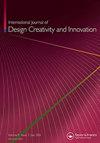Idea representation and elaboration in design inspiration and fixation experiments
IF 1.2
Q4 ENGINEERING, MANUFACTURING
International Journal of Design Creativity and Innovation
Pub Date : 2018-04-03
DOI:10.1080/21650349.2017.1362360
引用次数: 9
Abstract
Abstract Design fixation experiments often report that participants exposed to an example solution generate fewer ideas than those who were not. This reduced ‘idea fluency’ is generally explained as participants’ creativity being constrained by the example they have seen. However, the inclusion of an example also introduces other factors that might affect idea fluency in the experiments. We here offer an additional explanation for these results: participants not exposed to the example tend to generate ideas with little elaboration, while the level of detail in the example encourages a similar level of elaboration among stimulated participants. Because idea elaboration is time consuming, non-stimulated participants record more ideas overall. We investigated this hypothesis by reanalyzing data from three different studies; in two of them we found that non-stimulated participants generated more ideas and more ideas containing only text, whilst stimulated participants generated ideas that were more elaborated. Based on the creativity literature, we provide several explanations for the differences in results found across studies. Our findings and explanations have implications for the interpretation of creativity experiments reported to date and for the design of future studies.设计灵感与固定实验中的想法表达与阐述
抽象设计固定实验经常报告说,接触示例解决方案的参与者产生的想法比没有接触的参与者少。这种“想法流畅性”的降低通常被解释为参与者的创造力受到他们所看到的例子的限制。然而,一个例子的加入也引入了其他可能影响实验中思想流畅性的因素。我们在这里为这些结果提供了一个额外的解释:没有接触到例子的参与者往往会产生很少阐述的想法,而例子中的细节水平鼓励受刺激的参与者进行类似程度的阐述。由于构思是耗时的,未受刺激的参与者总体上会记录更多的想法。我们通过重新分析三项不同研究的数据来研究这一假设;在其中两项研究中,我们发现未受刺激的参与者产生了更多的想法和更多只包含文本的想法,而受刺激的与会者产生了更详细的想法。基于创造性文献,我们对研究结果的差异提供了几种解释。我们的发现和解释对迄今为止报道的创造力实验的解释和未来研究的设计都有启示。
本文章由计算机程序翻译,如有差异,请以英文原文为准。
求助全文
约1分钟内获得全文
求助全文
来源期刊

International Journal of Design Creativity and Innovation
ENGINEERING, MANUFACTURING-
CiteScore
3.80
自引率
27.80%
发文量
15
期刊介绍:
The International Journal of Design Creativity and Innovation is an international publication that provides a forum for discussing the nature and potential of creativity and innovation in design from both theoretical and practical perspectives. Design creativity and innovation is truly an interdisciplinary academic research field that will interest and stimulate researchers of engineering design, industrial design, architecture, art, and similar areas. The journal aims to not only promote existing research disciplines but also pioneer a new one that lies in the intermediate area between the domains of systems engineering, information technology, computer science, social science, artificial intelligence, cognitive science, psychology, philosophy, linguistics, and related fields. The journal covers, but is not restricted to, the following topics: ·Theories on Design Creativity and Innovation ·Cognition of Design Creativity ·Innovative Process ·Inventive Process ·Analogical Reasoning for Design Creativity and Innovation ·Design Synthesis ·Method and Tools for Design Creativity and Innovation ·Representation of Design Creativity and Innovation ·Education for Design Creativity and Innovation ·Concept Generation and Inspiration.
 求助内容:
求助内容: 应助结果提醒方式:
应助结果提醒方式:


